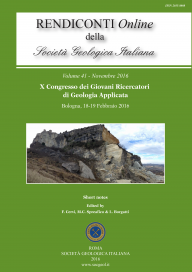
Rising groundwater levels and impacts in urban and semirural are around Naples (southern Italy)
Vincenzo Allocca (a), Silvio Coda (b), Pantaleone De Vita (a), Antonio Iorio (b) & Raffaele Viola (a)
(a) Department of Earth Science, Environment and Resources - University of Naples Federico II. Corresponding author: vincenzo.allocca@unina.it
(b) External collaborator
DOI: https://doi.org/10.3301/ROL.2016.81
Volume: 41/2016
Pages: 14-17
Abstract
The rising of groundwater levels in urban and rural areas is a relevant topic of the Urban Hydrogeology because it affects different areas of the world requiring specific analyses and mitigation measures by the institutions involved in the protection and security of the territory.
In the last century, in many developed countries processes of deindustrialization and urban transformation have caused the rising of groundwater levels and severe economic and social impacts.
The aim of this paper is to analyse the rising of groundwater levels in a multi-layered pyroclastic-alluvial aquifer, located in the coastal plain eastward of Naples (southern Italy) and its interactions with buildings and agricultural lands.
The research has been carried out by means of: i) analysis of stratigraphic settings by 86 boreholes and reconstruction of hydraulic conductivity logs; ii) reconstruction of a 2D hydrostratigraphic model of the multi-layered pyroclastic-alluvial aquifer; iii) slug test and multi-temporal hydrogeological monitoring of 83 wells, 9 piezometers and 12 river water levels; iv) analysis of daily rainfall time series; v) hydrogeological monitoring of impacted buildings and agricultural lands.
For the monitored period (November 2013-March 2015), the groundwater table showed a generalized rise, although with a spatial variability. The rise of groundwater levels ranged from a minimum of 0.10 meters, in the central and eastern sector of the study area, to a maximum of 2.05 meters, in the south-western sector, with an average growth rate of about 0.16 m.
The distribution of the impacted areas is not spatially homogeneous, and it was observed to vary over time. The hydrogeological interactions between groundwater and urban and rural areas are affected by: i) foundation types of buildings and the depth of the underground structures; ii) presence of shallow aquicludes (marshy clay-sands, clay-silts and peat levels) that determine local conditions of confinement for groundwater; iii) hydraulic efficiency and maintenance state of the dense network of drainage channels and micro-channels, which were historically built to drain surface water and groundwater in rural areas.
The obtained results provide the basic data to set up a numerical groundwater flow model, which is an indispensable tool to simulate and predict the hydrogeological effects of possible safeguard actions on urban and agricultural areas.
Keywords
Urban hydrogeology, groundwater level rise, alluvial aquifer, underground structures, agricultural soils, Naples, Italy.
Get Full Text